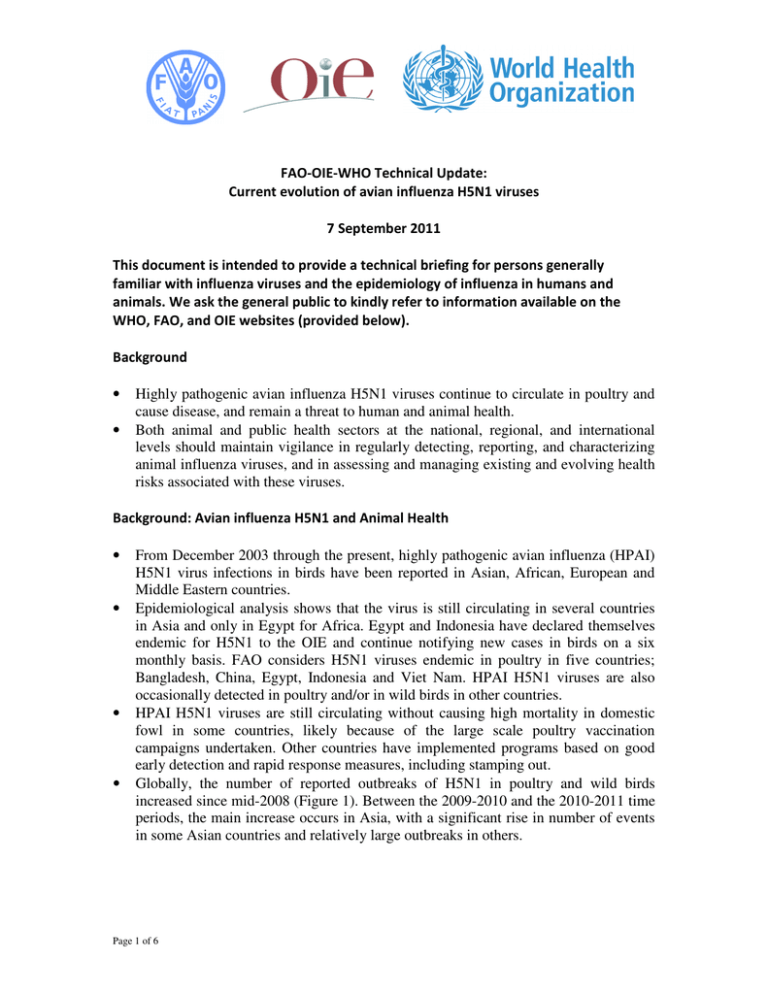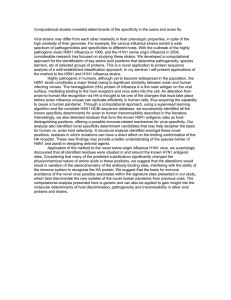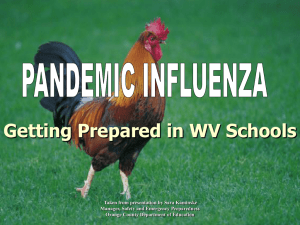FAO-OIE-WHO Technical Update: Current evolution of avian influenza H5N1 viruses
advertisement

FAO-OIE-WHO Technical Update: Current evolution of avian influenza H5N1 viruses 7 September 2011 This document is intended to provide a technical briefing for persons generally familiar with influenza viruses and the epidemiology of influenza in humans and animals. We ask the general public to kindly refer to information available on the WHO, FAO, and OIE websites (provided below). Background • • Highly pathogenic avian influenza H5N1 viruses continue to circulate in poultry and cause disease, and remain a threat to human and animal health. Both animal and public health sectors at the national, regional, and international levels should maintain vigilance in regularly detecting, reporting, and characterizing animal influenza viruses, and in assessing and managing existing and evolving health risks associated with these viruses. Background: Avian influenza H5N1 and Animal Health • • • • From December 2003 through the present, highly pathogenic avian influenza (HPAI) H5N1 virus infections in birds have been reported in Asian, African, European and Middle Eastern countries. Epidemiological analysis shows that the virus is still circulating in several countries in Asia and only in Egypt for Africa. Egypt and Indonesia have declared themselves endemic for H5N1 to the OIE and continue notifying new cases in birds on a six monthly basis. FAO considers H5N1 viruses endemic in poultry in five countries; Bangladesh, China, Egypt, Indonesia and Viet Nam. HPAI H5N1 viruses are also occasionally detected in poultry and/or in wild birds in other countries. HPAI H5N1 viruses are still circulating without causing high mortality in domestic fowl in some countries, likely because of the large scale poultry vaccination campaigns undertaken. Other countries have implemented programs based on good early detection and rapid response measures, including stamping out. Globally, the number of reported outbreaks of H5N1 in poultry and wild birds increased since mid-2008 (Figure 1). Between the 2009-2010 and the 2010-2011 time periods, the main increase occurs in Asia, with a significant rise in number of events in some Asian countries and relatively large outbreaks in others. Page 1 of 6 Figure 1. Number of confirmed HPAI H5N1 outbreaks in poultry and wild birds as of 31 August 2011 by month and region (figure: FAO, EMPRES-i) Background: Avian influenza H5N1 and Public Health • • • Based on available information, there is currently no increased public health risk posed by any circulating H5N1 virus. Human cases of H5N1 infection are rare and sporadic events, occurring mostly in areas where the virus is circulating endemically in poultry. Human cases could occur wherever the viruses are present in poultry and when humans might be exposed to infected birds or contaminated environments. Therefore sporadic human cases could be expected to occur as long as the virus continues to circulate in poultry. As of 31 August 2011, 565 confirmed human cases of infection with avian influenza H5N1 virus from 15 countries were reported to WHO (see Figure 2) since 2003. Of these, 331 died (case fatality rate: 58.6%). Epidemiologic investigations have Page 2 of 6 • identified only extremely limited human-to-human transmission of this virus since its emergence in 2003, and no sustained human-to-human spread. In those Asian countries that FAO considers endemic for H5N1 in poultry, the reported incidence of human cases has remained stable or has decreased since 2010. Figure 2: Number of confirmed Human H5N1 Cases by month of onset as of 2011-09-01 (Figure: WHO) • • • Eight human cases of H5N1 infection have been reported from Cambodia in 2011, all of which were in people under 19 years of age and all of which were fatal. This is the highest number of human H5N1 cases reported in one year from Cambodia. The basis for the increased incidence and the high mortality remain unclear. All of these cases represent sporadic infections likely related to exposure to sick poultry, and are not linked to each other, with the exception of a mother and her child. There is no evidence of sustained human-to-human transmission of H5N1 virus in Cambodia or any other country. Vigilance in epidemiologic and virological surveillance is important from the public health perspective for ensuring both early treatment of cases and early detection of clusters (one or more human cases grouped in time and location) indicating possible human-to-human transmissibility of viruses. Vigilance is likewise important in the various poultry sectors to address epidemiologic links to human cases and possible occupational health risks. Virus evolution and nomenclature: general • There is currently no evidence that any particular H5N1 virus is more virulent in or transmissible among or between birds or humans. Page 3 of 6 • • • • • • • • All influenza viruses evolve ( i.e. slowly change genetically through a series of very small mutations) as they circulate in human and animal populations. They are then grouped into “clades” based on their genetic similarity. In general, as mutations in the viral genetic sequences of influenza viruses accumulate, changes in the antigenic characteristics of the viruses may also occur. Influenza viruses also occasionally reassort with other influenza viruses, resulting in larger changes. Predictably, the avian influenza H5N1 viruses also continue to evolve, especially in areas where they circulate endemically in poultry. The slowly evolving viruses are periodically regrouped and assigned new clade names. One clade, recently named H5N1 clade 2.3.2.1 has evolved from clade 2.3.2 viruses previously circulating among poultry in the eastern Asia since 2005. This clade has been increasingly found in poultry in several countries, and in some areas has become predominant over previously circulating clades. Hence, clade 2.3.2.1 viruses are not “new”. An older clade of H5N1 viruses, named clade 1, is now being reported only from southern Viet Nam and Cambodia. To date (September 2011), only clade 1 viruses have ever been isolated from humans and animals in Cambodia. The clade “nomenclature” (i.e. method of naming) for H5N1 viruses is regularly addressed by the standing WHO/FAO/OIE H5N1 Evolution Working Group. Maintaining a standard H5N1 clade nomenclature is important for effective communications among scientists working in the animal health and public health sectors, among influenza researchers, and with the public. An update of the H5N1 clade nomenclature incorporating information from the evolving variants of the 2.3.2 clade, including updated phylogenetic trees, will be posted by WHO and its partners. The evolution of H5N1 viruses impacts vaccine and diagnostic test development for both humans and birds. The spread of any evolving clade, especially those that are genetically or antigenically distant, requires updated vaccines for improved efficacy and updated diagnostic assays for their detection. Virus evolution and nomenclature: Animal health • • • 1 The evolution of avian influenza viruses, including H5N1 viruses, impacts the poultry industry, and thus also the livelihoods and food security of many people, especially in developing countries. It is known that with evolution of the H5N1 viruses, antigenic changes can occur which affect cross protection of available poultry vaccines. In Viet Nam, a major change in circulating virus clades took place in the northern part of the country. The previously dominant clade 2.3.4 has been replaced by clade 2.3.2.1. (“Evolution of virus clades in Viet Nam”, 7 Sept 2011, FAOAIDEnews, (80) p. 6)1. In southern Viet Nam clade 1 remains the predominant clade. http://www.fao.org/docrep/014/al873e/al873e00.pdf Page 4 of 6 • • • • Viet Nam has been using the poultry vaccines based on H5N1 clade 0 (since 2005 until 2010) and clade 2.3.4 (since 2011). These vaccines are still effective for clade 2.3.2.1 viruses except one antigenic variant found in 2011. This highlights the importance of regular monitoring of virus evolution and updating poultry influenza vaccines accordingly, as well as the need to use different vaccine strains in different regions. Wild birds are known to be the reservoir of low pathogenicity avian influenza (LPAI) viruses, but not all of them are H5N1. H5N1 viruses have been the cause of large number of wild bird deaths; but in intensive surveillance schemes in Europe, North America, Asia, and Africa encompassing some 750,000 samples, very few healthy wild birds have been found to harbour H5N1 viruses. They are not considered the reservoir of this virus. Virus evolution and nomenclature: Human health • • • There is currently no evidence that any particular clade or strain of the H5N1 virus, including any newly evolved clade, is more transmissible or pathogenic in humans. Although three human cases of H5N1 virus infection have been associated with clade 2.3.2.1 viruses 2 , there is no indication that clade 2.3.2.1 viruses pose any greater threat to human health than any of the other H5N1 viruses. As viruses spread more widely and intensively in poultry and wild birds, the likelihood of human exposures to infected birds increases. However, this does not increase the ability of the viruses to infect and transmit between people. Three clade 2.3.2.1 viruses have already been identified by WHO’s Global Influenza Surveillance and Response System (GISRS; the group of experts that studies animal and human influenza viruses that may impact human health) to be considered for inclusion in future human inter-pandemic H5N1 vaccine viruses if needed.3 References Tripartite: WHO/FAO/OIE H5N1 Evolution Working Group: http://www.who.int/csr/disease/avian_influenza/guidelines/nomenclature/en/index.html Animal health: OIE WAHID - World Animal Health Information database, 2011 http://web.oie.int/wahis/public.php?page=disease_immediate_summary&selected_year=2011 2 A/Vietnam/HN36234/2010, A/Hubei/1/2010 and A/Guangxi/1/2009 An A/Hubei/1/2010-likeand an A/barn swallow/Hong Kong/D10-1161/2010-like virus, as reported by WHO in February 2011 and an A/common magpie/hk/07like reported by WHO previously 3 Page 5 of 6 OIE Update on Highly Pathogenic Avian Influenza in Animals http://www.oie.int/en/animal-health-in-the-world/update-on-avian-influenza/2011/ FAO Emergency Prevention System’s EMPRES-i http://empres-i.fao.org/empres-i/home FAO H5N1 Highly Pathogenic Avian Influenza Monthly Overview - April/June 2011 http://www.fao.org/docrep/014/am722e/am722e00.pdf FAO Avian Influenza Page http://www.fao.org/avianflu/en/index.html FAO comments on 2010 distribution of H5N1 viruses: http://www.offlu.net/OFFLU%20Site/H5N1%20worldwide%20in%202010_for_OFFLU.pdf Evolution of virus clades in Viet Nam, 7 Sept 2011, FAOAIDEnews, (80) p. 6 http://www.fao.org/docrep/014/al873e/al873e00.pdf OFFLU strategy document for surveillance and monitoring of influenzas in animals http://offlu.net/OFFLU%20Site/OFFLUsurveillancepH1N1_180110.pdf Public health: WHO Influenza at the Human-Animal Interface webpage: http://www.who.int/influenza/human_animal_interface/en/ WHO Risk Assessment Summary: Influenza at the Human-Animal Interface http://www.who.int/influenza/human_animal_interface/avian_influenza/Influenza_Summary_IRA_H A_interface.pdf Cumulative Number of Confirmed Human Cases of Avian Influenza A/(H5N1) Reported to WHO: http://www.who.int/csr/disease/avian_influenza/country/ Antigenic and genetic characteristics of influenza A(H5N1) and influenza A(H9N2) viruses for the development of candidate vaccine viruses for pandemic preparedness: http://www.who.int/csr/disease/avian_influenza/guidelines/2011_02_h5_h9_vaccinevirusupdate.pdf Page 6 of 6





